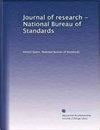Biological Reference Materials for Trace Element Analysis: What is New?
Journal of research of the National Bureau of Standards
Pub Date : 1988-05-01
DOI:10.6028/jres.093.060
引用次数: 1
Abstract
In biomedical trace element research, reference materials are a relatively recent development: indeed, Bowen's Kale Powder became available only in the middle of the 1960s, NBS Orchard Leaves (SRM 1571) and NBS Bovine Liver (SRM 1577) in the beginning of the 1970s. In general, when compared to a number of real samples submitted to laboratories for elemental analyses, these reference materials have high or relatively high trace element concentrations. This is probably best illustrated when the levels expected in human blood plasma or serum (matrices which are frequently analyzed both because of their established biomedical importance and their ready availability) are considered. For example, for chromium and manganese, figures are as follows-370 and 14,950 ng/g (in Bowen's Kale Powder), 88 and 10,300 ng/g (in NBS Bovine Liver), and 1.5 and 5.5 ng/g dry weight (in human blood plasma or serum). So, although the above-mentioned, first generation biological reference materials rendered excellent services as a means to check the accuracy and precision of analytical techniques, large numbers of investigators were still largely left to their own devices. Some reference materials are specifically aimed at researchers working on human blood plasma or serum, e.g., NBS Human Serum (SRM 909), Nycomed's Human Serum (STE 105), and National Institute for Environmental Studies' (NIES) (Japan) Freeze-Dried Human Serum. In all three cases, however, it is obvious that the original levels of several elements must have been drastically distorted during the collection and preparation of the痕量元素分析的生物标准物质:有什么新进展?
在生物医学微量元素研究中,标准物质是一个相对较新的发展:事实上,Bowen’s Kale Powder在20世纪60年代中期才出现,NBS果园叶(SRM 1571)和NBS牛肝(SRM 1577)在20世纪70年代初才出现。一般来说,与提交实验室进行元素分析的实际样品相比,这些参考物质具有较高或相对较高的微量元素浓度。考虑到人血浆或血清(由于其已确立的生物医学重要性和现成可用性,经常对其进行分析的基质)中预期的水平,可能最能说明这一点。例如,铬和锰的含量如下:370和14950纳克/克(鲍文羽衣甘蓝粉),88和10300纳克/克(NBS牛肝),1.5和5.5纳克/克干重(人血浆或血清)。因此,尽管上述第一代生物标准材料作为检查分析技术的准确性和精密度的手段提供了出色的服务,但大量的研究人员仍然在很大程度上是自行其是的。一些参考材料专门针对从事人血浆或血清研究的研究人员,例如,NBS人血清(SRM 909), Nycomed人血清(STE 105)和国家环境研究所(NIES)(日本)冻干人血清。然而,在这三种情况下,很明显,在收集和准备样品的过程中,有几种元素的原始水平肯定被严重扭曲了
本文章由计算机程序翻译,如有差异,请以英文原文为准。
求助全文
约1分钟内获得全文
求助全文

 求助内容:
求助内容: 应助结果提醒方式:
应助结果提醒方式:


